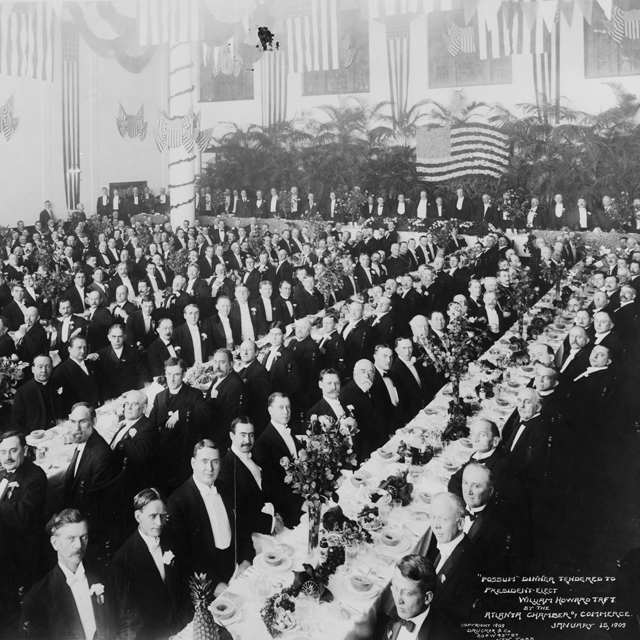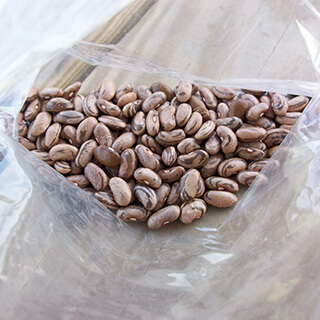Overview
Ariel Lawrence reviews Bobby J. Smith II's Food Power Politics: The Food Story of the Mississippi Civil Rights Movement (Chapel Hill: University of North Carolina Press, 2023).
Introduction
The soil in the Mississippi Delta has everything a planter needs. Rooted in shallow soils, elm, cottonwood, and pecan trees line the hilly landscapes of eastern and southern Mississippi. In the bottomland, where the soil is formed by flooding, the endless striations of light and dark colored sediment create moist, rich, and nutrient-dense dirt in which cash crops like corn, soybeans, and cotton thrive. The Mississippi River and all its branches flow over the boundaries of its own banks, flooding the soil and adding new sediment, giving it new life. On the banks of the Mississippi between Coahoma and Sunflower counties, sits Bolivar County and the city of Mound Bayou. Founded in 1887 near Chickasaw burial grounds by a trio of formerly enslaved cousins, Mound Bayou emerged in the Reconstruction era as a burgeoning example of what African American autonomy could become in the dissolution of slavery.1Joel Nathan Rosen, “Mound Bayou,” Mississippi Encyclopedia, July 11, 2017, https://mississippiencyclopedia.org/entries/mound-bayou/. At its height, Mound Bayou, the “Jewel of the Delta,” housed successful Black businesses, a public school system, and a community-run hospital.2Rosen, “Mound Bayou.” Seen as a safe haven from the physical and political interference of white people and power structures, Mound Bayou fought to maintain its autonomy, eventually succumbing to mismanagement and political in-fighting. By the 1960s, while attention was on the southern United States in the fight for civil rights and political enfranchisement, Mound Bayou, like many other Black towns in the twentieth century, languished under the threat of anti-Black, state-sanctioned violence and economic inequity. While historians often place voting rights at the heart of the civil rights movement, in Mississippi, for Black farmers, sharecroppers, and their families, the gut of the matter was food.
A contribution to critical food studies, Bobby J. Smith II’s 2023 Food Power Politics: The Food Story of the Mississippi Civil Rights Movement, details the role of plantation politics, food scarcity, and Black autonomy across the Delta from the mid-1960s through the early 1980s. In addition to thinking about power, equity, and accessibility, Smith’s work deals specifically with the experiences of Black communities in the Delta—places such as Leflore, Sunflower, and North Bolivar counties—and builds on recent scholarship covering the pinnacles and nadirs of the civil rights movement. According to Smith (a professor of African American Studies at the University of Illinois), the emphasis of scholarship on voting rights and education in the civil rights era neglects the more fundamental problem of subsistence. The primary critical intervention Smith presents in Food Power Politics is his insistence that the subject of food equity allows readers to “identify social, political, and economic blind spots...at the core of social protest and power struggles” both past and present.3Bobby J. Smith, Food Power Politics (Chapel Hill: University of North Carolina Press, 2023), 9. Smith aims to “expand the civil rights story” by illustrating how the lack of access to nutritional food and nourishment motivated sharecroppers, farmers, and rural working-class families on the periphery of Black life in the US to “[pave] the way for new articulations of civil rights activism.”4Smith, Food Power Politics, 142. Examining food access and equity shifts attention to the environmental and psychological vulnerabilities of Black bodies.

The social, political, and biological aftershocks of the plantation system in and after the era of “King Cotton” are too massive to quantify. As Mikko Saikku reminds us, despite the “great personal fortunes” cultivated across the 19th and 20th centuries through the "biological productivity" of the Mississippi Delta, "[for] most of the people involved in the transformation of the Delta bottomlands, especially black slaves, sharecroppers and agricultural workers, economic gain and social mobility remained severely limited.”5Mikko Saikku, "Bioregional Approach to Southern History: The Yazoo-Mississippi Delta," Southern Spaces, January 28, 2010, https://southernspaces.org/2010/bioregional-approach-southern-history-yazoo-mississippi-delta/. As a response and challenge to these limitations, Smith constructs the food story of Mississippi by drawing on civil rights era archives and ethnographies. Examining documents from Tougaloo College Civil Rights Collection, the Mississippi Department of Archives and History, and the Mississippi Council on Human Relations, alongside local newspaper reportage, Smith also draws upon a diverse range of print media and correspondence, including personal letters from civil rights activists such as Medgar Evers and Fannie Lou Hamer. He also conducted interviews with activists and agricultural workers active in the 1960s and today in north Bolivar County.
Key to Smith’s analysis are the concepts of food power and emancipatory food power. Food power, most often deployed when describing international wars and political conflict, gestures towards moments where, within “a hierarchical world system” access to food or food related autonomy is “weaponized...as a form of control between nations” to influence outcomes.6Smith, Food Power Politics, 2. Food power guides the first two chapters of Smith’s book through an examination of the 1962 Greenwood Food Blockade and the Lewis Grocer Company’s campaign for a federal food stamps program in Mississippi. State and local government, as well as private corporations, wielded food power against Black farmers, sharecroppers, and working-class people to continue the racist inequities of the antebellum plantation system.

The second half of Food Power Politics illustrates emancipatory food power—ways that Black activists, citizens, and farmers restructured the power dynamics imposed on them by the white plantation class through the creation of an autonomous food economy in service to the needs, desire, and tastes of Black rural people. Smith writes extensively about the North Bolivar County Food Cooperative (NBCFC), founded in 1967, and its contemporary iteration, the North Bolivar County Good Food Revolution (NBCGFR), a predominantly youth-led food justice movement that emerged in 2017. Here, the line between food power and emancipatory food power is not conceptual or theoretical. The emancipatory power of Black food autonomy depends on economic independence fueled, in part, through land ownership, as well as food literacy, agricultural education, and the material labor of Black people. While Smith’s project is rooted in the geographies and spatialities of the Delta, it also surveys other places often minimized or misunderstood through standard histories of the civil rights years.
Food Power Politics asks that we consider the space of the plantation not only as a physical landscape of endless rows of cotton stalks but also as spaces constructed by and in service to white social and economic domination over Black people. The attitude of the plantation can be found in the white-owned grocery store as much as in the field. In considering Black women as mothers, planters, laborers, and activists, Smith asks us to consider Black domestic space, represented iconically in the kitchen table, as the launching pad for political revolution.
Debt, Plantations, and Black Hunger: On Food Power
During and after Reconstruction, the sharecropping system continued to support the hierarchy and politics of the plantation ruling class in the Deep South. While millions of formerly enslaved persons flowed north and west during the Great Migration, those who remained had limited options for employment. Many Black farmers and agricultural workers found themselves working for the descendants of former slave masters on the same plantations where their ancestors labored in bondage. Food access was negotiated through small gardens on plots of land leased from plantation owner. These “truck patches” supplied subsistence nourishment. Additionally, many sharecropper households traded homestead goods with other families, creating networks of care and support. Many also depended upon New Deal era federal food programs. Similar to the exploitative credit system that forced Black farmers to lease land and equipment from plantation owners at outrageous interest rates, access to food in Mississippi during the 1960s was deeply entwined with the afterlife of the plantation system. The fiscal and social politics of the plantation era made itself known through the converged interests of plantation owners and private white grocers such as the Lewis Grocer Company, which conspired to suppress Black political and economic autonomy through the twinned threats of food scarcity and political disenfranchisement.

Three factors shaped the proliferation of food-centric oppression for the Black rural and working class in Mississippi during the 1960s: the mechanization of the plantation system, the transition from government-sponsored surplus goods programs to that of the federal Food Stamp Program, and the change in minimum wage laws surrounding farm workers and sharecroppers in the Delta. In the era of “King Cotton,” the means of cultivating and harvesting this cash crop became more dependent on government-leased technology, machinery, and chemicals, and less dependent on manual labor. The sudden decline of job opportunities, the shift from daily to hourly wages for plantation labor, and the emergence of a food stamp system which deepened sharecroppers’ dependence on systems of credit were major forces of oppressive food power wielded over Black farmers and their families by white capitalist elites in the Delta. The triangulation of these events forced sharecroppers and their families into structural over-dependency and debt, creating seemingly inescapable cycles of poverty.
Among these dire systemic restrictions, food scarcity was also strategically deployed by white government officials in LeFlore County through the 1962–1963 Greenwood Food Blockade. The county board of supervisors’ decision to pull out of the federal surplus commodities program, a major food source for Black sharecroppers and farm workers, further spurred food scarcity. Similar strategies of food suppression were deployed in Tennessee in 1960 and in nearby Sunflower County in 1962. These actions aimed not only to starve out the Black rural class and keep them further under the control of credit systems deployed by plantation owners and grocers but also to intimidate the burgeoning rise of Black voter registration taking place across the South. The Food for Freedom program, created by the Student Nonviolent Coordinating Committee (SNCC) and Council of Federated Organizations (COFO) just a few weeks after the start of the blockade, addressed the needs of Black people in Greenwood by providing food, aid, and support through local and regional systems of distribution. With the help of local activists, as well as public figures such as Martin Luther King, Jr. and comedian Dick Gregory, the Food for Freedom program brought attention and material support to those in need and helped to end the blockade in March 1963. In this process, SNCC was able to make a concerted effort to explicitly connect food and activism to highlight the “relationship between food, everyday Black resistance, white supremacy, and state sanctioned violence during the civil rights era.”7Smith, Food Power Politics, 42. Smith illustrates in detail how plantation owners and grocers strategically displaced Black food autonomy with debt-centric practices, which forced Black sharecroppers and farmers to depend on the state for access to food. This history is painfully ironic, given the current political rhetoric in Mississippi that centers public welfare programs as a threat, best exemplified by Mississippi Governor Tate Reeves’s (R) refusal to participate in a federally funded program aimed at supporting food access for children in the summer months. Gov. Reeves's rejection of the program, justified by his dedication to not “expand the welfare state,” illustrates how inequitable practices of food power remain active in Mississippi.8Gloria Oladipo, “Mississippi Quits Child Food Program amid Republican ‘Welfare State’ Attack,” The Guardian, January 13, 2024, https://www.theguardian.com/us-news/2024/jan/13/mississippi-child-school-food-program-welfare-state.
Autonomy and/as Collard Greens: On Emancipatory Food Power
The Food for Freedom program is one of three examples of emancipatory food power that Smith highlights in his book. The most expansive is the NBCFC, a Black-owned and operated food cooperative founded in 1967 with the goal of becoming an autonomous food economy in Mississippi. Spearheaded by activist L.C. Dorsey, with the help of other Black mothers and community members, this cooperative began as a garden project for low-income families. At its peak, the NBCFC operated a farming operation across almost 1,500 acres (owned and leased) to cultivate crops for the poorest families in Bolivar. Pushing against the monocrop culture that had rendered many Black sharecroppers jobless, the NBCFC grew crops that would meet nutritional needs: protein-rich nuts, peas and beans, vitamin-dense greens and okra, as well as staple carbohydrates like rice, potatoes, and corn. During the summer, watermelon vines as well as peach orchards and pecan trees were prioritized for local enjoyment. The NBCFC illustrated how Black autonomy functions beyond the strictures of capitalistic profit.
While land acquisition was central to NBCFC’s vision of food autonomy, so were labor practices and education. The cooperative dedicated over 70% of its labor budget to employing local members, bringing jobs to more than three hundred families. It partnered with the Department of Horticulture at Mississippi University alongside agricultural educators from Atlanta University, Iowa State, and Michigan State to offer courses in farm management, soil conservation, and food production. Food literacy was a primary goal of outreach, instructing Black mothers on how to prepare the foods distributed to them through the cooperative in ways that would support the health and wellbeing of the household. Land acquisition, farm production, and agricultural education centered the NBCFC’s vision of emancipatory food power. That workers were able, even for a short period, to labor in a system that would feed and train them to become more self-sufficient—financially and politically—on the land where they lived, worked, and sought to thrive was a radical feat reshaping what freedom could envision.

After five years of operation, the NBCFC began a decline in the 1970s due to leadership infighting, disagreements, and the loss of grant funding. The organization was unable to complete its long-term goals of creating an on-site canning operation for national distribution of NBCFC foods and developing a Black-owned and operated farm supply store that might further offer farmers the opportunity to cultivate their own land without interference from white plantation owners. Still, Smith narrates their journey in this unique and palpable moment. The legacy of the NBCFC is alive in the youth-run North Bolivar County Good Food Revolution (NBCGFR).
The joy of Food Power Politics comes in its gesturing towards civil rights beyond voting and government, in expanding understanding of what Black autonomy can be. The most striking cultural memories of the civil rights era, often exemplified by photographic images of Black bodies in pain and duress, contribute to a taste for spectacle that continues. The exploration of hunger as a threat fueled and facilitated by white supremacy is a subject requiring more attention.
Food Power Politics explores spaces and places often overlooked by civil rights historians. Smith explores the Delta from the soil up, balancing a long history of food injustice, narrating the story with an avid appetite for meticulous detail. If any dimension is slighted, it’s the missed opportunity to fully explore the role of Black women activists and their influence on emancipatory food power. Smith is deft to note that, while Black women were and remain active participants in the NBCFC and NBCGFR, the question of how to emancipate Black people from food scarcity, while also emancipating Black women from the invisible labor of the domestic space, remains underdeveloped. While Smith mentions the work of well-known Black food activists such as Fannie Lou Hamer, and other important figures such as Dorsey, Unita Blackwell, and Marian Wright, he and other food studies scholars should further articulate what a Black Feminist approach to food equity might consist of. Such an endeavor would take seriously how Black women’s material and political labor has been intentionally miscategorized and rhetorically devalued within historical narratives. It would also acknowledge the murky history of Black patriarchal structures that relegate, and obscure, the nurturing networks of care constructed by Black women activists to the realm of the domestic and private. In this, we can better understand how a Black Feminist approach to food equity would address an equity of labor and care within the Black domestic space irrespective of gender, class, or sexuality.

The core aim of Food Power Politics is to construct an alternative history of food power in the Delta, and in that, Smith succeeds. Further, Smith’s text places into perspective the long history of community organizing, direct action, and educational activism that rural and working-class Black Americans have relied on in the face of economic and social dispossession. Instead of debating the legitimacy of trickle-down activism from hyper-visible politicians and celebrities, Smith reminds us that, historically, political victories and social justice reform sprouts from the bottom up. 
About the Author
Ariel Lawrence is a PhD candidate in the English Department at Emory University. Her research focuses on Black women-authored lifewriting across multiple genres, and the articulation of ethical reading practices in and beyond the page.
Recommended Resources
Text
Ferris, Marcie Cohen. The Edible South: The Power of Food and the Making of an American Region. Chapel Hill: University of North Carolina Press, 2014.
Kornbluh, Felicia. "Food as a Civil Right: Hunger, Work, and Welfare in the South after the Civil Rights Act." Labor: Studies in Working-Class History 12, no. 1–2 (2015): 135–158.
McDonald, Bryan L. Food Power: The Rise and Fall of the Postwar American Food System. New York: Oxford University Press, 2016.
Williams-Forson, Psyche A. Building Houses Out of Chicken Legs: Black Women, Food, and Power. Chapel Hill: University of North Carolina Press, 2006.
Web
Delta Fresh Foods. "North Bolivar County Good Food Revolution." Accessed January 29, 2024. http://www.deltafreshfoods.org/practice-areas.html.
Newkirk, Vann R. II. "The Great Land Robbery: The Shameful Story of How 1 Million Black Families Have Been Ripped from Their Farms." The Atlantic. September 29, 2019. https://www.theatlantic.com/magazine/archive/2019/09/this-land-was-our-land/594742/.
Smith, Bobby J. II. "Mississippi's War Against the War on Poverty: Food Power, Hunger, and White Supremacy." Study the South. July 1, 2019. https://southernstudies.olemiss.edu/study-the-south/ms-war-against-war-on-poverty/.
Similar Publications
| 1. | Joel Nathan Rosen, “Mound Bayou,” Mississippi Encyclopedia, July 11, 2017, https://mississippiencyclopedia.org/entries/mound-bayou/. |
|---|---|
| 2. | Rosen, “Mound Bayou.” |
| 3. | Bobby J. Smith, Food Power Politics (Chapel Hill: University of North Carolina Press, 2023), 9. |
| 4. | Smith, Food Power Politics, 142. |
| 5. | Mikko Saikku, "Bioregional Approach to Southern History: The Yazoo-Mississippi Delta," Southern Spaces, January 28, 2010, https://southernspaces.org/2010/bioregional-approach-southern-history-yazoo-mississippi-delta/. |
| 6. | Smith, Food Power Politics, 2. |
| 7. | Smith, Food Power Politics, 42. |
| 8. | Gloria Oladipo, “Mississippi Quits Child Food Program amid Republican ‘Welfare State’ Attack,” The Guardian, January 13, 2024, https://www.theguardian.com/us-news/2024/jan/13/mississippi-child-school-food-program-welfare-state. |







